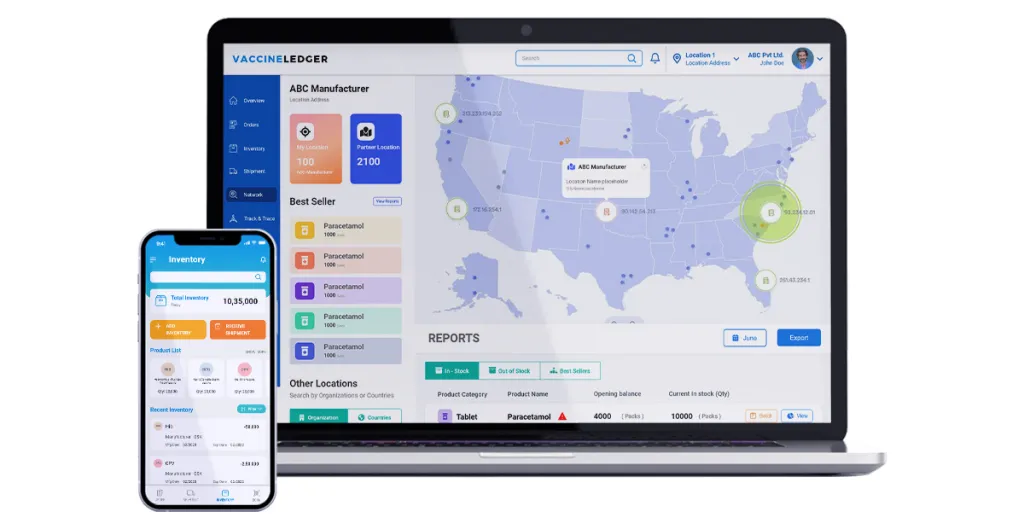Supply Chain Management is not as simple as it looks. It is much more than managing the flow of goods and services from one stakeholder to another. It requires the management of a huge amount of data that is produced at every stage and turning it into analytics that will help optimize the supply chain. StaTwig’s Cognitive Network is built for the same purpose, i.e., organizing the raw data and transforming them into actionable insights. Before we dig deeper into it, let’s have a glimpse at the current state of the Global Supply Chain and its challenges.
StaTwig’s Cognitive Network: A Better Way to Enhance Extended Supply Chain
Supply Chain
July 15, 2022

Status Quo of the Global Supply Chain
The global supply chain is complex and fragmented. It comprises several stakeholders including Manufacturers, Suppliers, Carrying and Forwarding Agents, Distributors and Retailers who facilitate the flow of resources and information around the globe. The primary aim of all these stakeholders is to maximize the profit and at the same time, minimize the disruptions to provide the timely delivery of goods and services which in turn improves customer satisfaction. Since there is no interconnectivity between the information system of the stakeholders, they lack visibility in their network which leads to problems such as stockouts, product expiries, counterfeiting, black marketing, and cold chain failures.
Existing Problems in Supply Chain

Problems in Supply Chain
Supply chain visibility is critical for a healthy business especially when we consider its complexity. For instance, when a customer receives a counterfeit product of degraded quality, manufacturers are the ones who bear the entire loss and it also leads to customer dissatisfaction compromising the brand integrity. Due to lack of visibility, manufacturers will not be able to identify the point where the counterfeit product was introduced. This is just one of the many scenarios that can occur in your network. Lack of supply chain visibility can lead to many problems which are described below:
Mismanagement of Stocks
Lack of real-time supply chain visibility will lead to mismanagement of stocks. Both stock-outs and non-value-adding inventories attribute to opportunity costs in terms of lost sales or tied-up capital. Inventory overstocking also leads to a huge amount of wastage, as it leads to product expiration causing enormous losses to manufacturers due to product recalls. Without advanced demand forecasting techniques, this problem will persist.
Improper Data Management
Every day a huge amount of data is generated in a supply chain right from the procurement of raw data till it is transformed into a finished product and reaches the end beneficiary. But if they are spread across unrelated systems, they’ll not be able to generate actionable insight which helps stakeholders to predict challenges and act upon them. Even if they are shared, how would you make sure that the data you are dealing with is trustworthy? This problem exists because it is difficult with current supply chain management tools to get complete visibility of the products in the supply chain because they create data silos.
Bottlenecks
Starting from the procurement of raw materials to delivering the finished product to the customer, there can be many bottlenecks that can impact the efficiency of operations. For instance, there is a huge demand for a product from the customer side, but if the manufacturer is not able to recruit raw material for the product, the production process gets hampered. If you don’t have enough visibility in the supply chain, there is a huge possibility that you misunderstand the problem.
Disruptions
Supply chain disruptions can be caused due to both local events like labor strikes, natural disasters, and transportation failures or global events like Pandemic. Lack of supply chain visibility prevents stakeholders from taking immediate and appropriate actions which ultimately causes inconvenience to the end customer.
What is Needed?
There is a need for an easy-to-use digital tool that can provide complete visibility of the products in the supply chain, right from the procurement of the raw material till it reaches the customer as a finished product. A platform that creates a decentralized network and connects each stakeholder in the supply chain enabling them to share data in a secured and authorized manner. A platform that lets the stakeholders know where the product is, how it got there and where it is heading. It should be able to analyze all the data collected and provide real-time insights aiding an individual in making good business decisions.
Introduction to the Cognitive Network
Statwig’s cognitive network, built upon blockchain technology, helps you track your product and ensure its safety as it moves from the manufacturer to the customer. It is built on the foundation of Trust, Transparency and Authenticity. For every physical product out there in the supply chain, we create a digital twin which connects the real and digital world by collecting real-time data in the decentralized network. These collected data are then analyzed to produce business insights enabling stakeholders to take instant action on any kind of problem faced in the supply chain.
How will this change the Status Quo?

data sharing
Real-Time Inventory Management
Manufacturers will have complete visibility of the products that are there in different locations not only in their network but also in the extended network where they do not have any custody of the products. This in turn aids them to make accurate demand forecasting and wastage reduction. This will also help manufacturers to implement efficient production planning which will minimize stockouts and non-value-adding inventories.
Efficient Data Management
It structures the data collected and makes them understandable. It establishes relations between the collected data to produce meaningful insights. For instance, a user searches for a product using its serial number. They get all the product-related information like manufacturing details, whereabouts, storage conditions (in case it’s a sensitive product), chain of custody, etc.
Resolving Bottlenecks
In case of any bottlenecks in the supply chain, Cognitive Network enables you to correctly analyze them and aids in finding the right solution for them. For instance, you might not be getting supplies at the right time, which causes a halt in the production process. With complete visibility, you identify that it was not the supplier who was late but it was the insufficient docking space for the suppliers in the morning time. So now you know that the correct solution will be to optimize your shipment schedule but not to change the supplier.
Minimize Disruption
Many of the disruptions in the supply chain can be resolved if they are known to the respective stakeholders at the right time. For instance, if there are labor disputes at the location of the supplier due to which shipment is getting delayed, manufacturers are alerted about the situation enabling them to take immediate actions like looking for alternative suppliers who can deliver the supplies at the right time.
Conclusion
The above-stated solution is not an exhaustive list of benefits of our Cognitive Network. In fact, it is a highly scalable technology and with slight modifications, it can be used across any type of supply chain be it Pharmaceutical Supply Chain (where one deals with temperature-sensitive drugs), Aviation Supply Chain (where one deals with the expensive product) or Food & Beverages Supply Chain (where one deals with sensitive products with low shelf life). To know more about groundbreaking solutions visit StaTwig’s website
© StaTwig 2023. All Rights Reserved.



